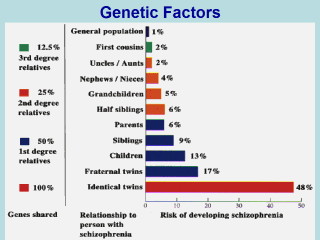| front |1 |2 |3 |4 |5 |6 |7 |8 |9 |10 |11 |12 |13 |14 |15 |16 |17 |18 |19 |20 |21 |22 |23 |24 |25 |26 |27 |28 |review |
 |
Source of diagram: Princeton University:
http://www.molbio.princeton.edu/courses/mb427/1999/projects/9902/genetics.htm
Schizophrenia has a significant hereditary component. The cumulative evidence from over a century of research strongly implicates genes in the etiology of schizophrenia. Twin studies consistently find higher concordance rates of schizophrenia among monozygotic (MZ) twins than among dizygotic (DZ) twins, and adoption studies show that familial transmission is mostly mediated by genetic, not adoptive, relationships. No single major “schizophrenia gene” has yet been discovered. Mathematical analyses suggest that many genes are involved, and that the effect of any single gene on risk for schizophrenia is likely to be small. Nevertheless, the correlation of schizophrenia between identical twins, who have identical genomes, is less than one-half. This indicates that schizophrenia is not entirely a genetic disease. In sum there are likely to a number of genes that contribute to the susceptibility or pathology of schizophrenia, but none are fully responsibility for the disease. Schizophrenia appears much like cancer, which has a complex causality through the interaction of a number of genetic and environmental factors. |